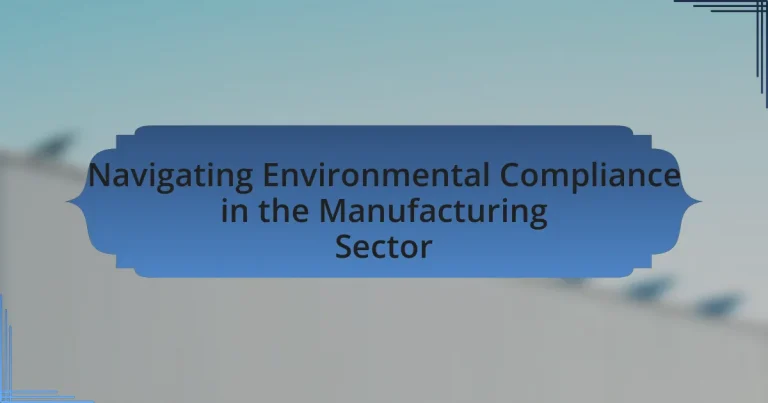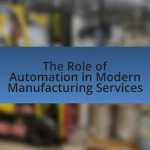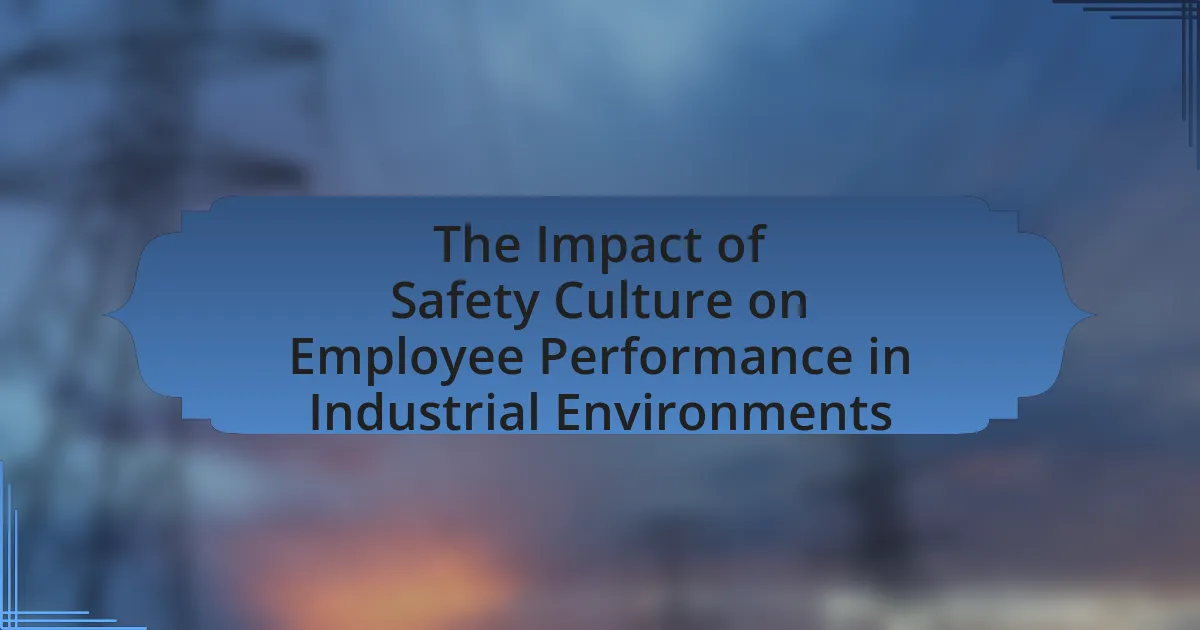Environmental compliance in the manufacturing sector involves adhering to laws, regulations, and standards that mitigate the environmental impact of manufacturing activities. This article outlines the importance of compliance for manufacturers, highlighting the potential consequences of non-compliance, including financial penalties and reputational damage. Key regulations such as the Clean Air Act and Clean Water Act are discussed, along with the role of federal and state regulations, international standards, and the challenges manufacturers face in achieving compliance. Strategies for effective compliance management, including the implementation of environmental management systems, employee training, and the use of technology, are also examined, providing a comprehensive overview of best practices and resources available to support manufacturers in navigating environmental compliance.
What is Environmental Compliance in the Manufacturing Sector?

Environmental compliance in the manufacturing sector refers to the adherence to environmental laws, regulations, and standards that govern the impact of manufacturing activities on the environment. This compliance ensures that manufacturers operate within legal frameworks designed to protect air, water, and land quality, thereby minimizing pollution and resource depletion. For instance, the Clean Air Act and the Clean Water Act in the United States set specific limits on emissions and discharges, which manufacturers must follow to avoid penalties and promote sustainable practices.
Why is Environmental Compliance important for manufacturers?
Environmental compliance is crucial for manufacturers because it ensures adherence to laws and regulations that protect the environment. Compliance helps manufacturers avoid legal penalties, which can include fines and sanctions, thereby safeguarding their financial stability. Additionally, maintaining environmental standards enhances a manufacturer’s reputation, attracting environmentally conscious consumers and investors. According to a report by the World Economic Forum, companies that prioritize sustainability can see a 20% increase in profitability over time. Therefore, environmental compliance not only mitigates risks but also contributes to long-term business success.
What are the potential consequences of non-compliance?
The potential consequences of non-compliance in the manufacturing sector include significant financial penalties, legal repercussions, and reputational damage. Financial penalties can range from thousands to millions of dollars, depending on the severity of the violation and the regulatory framework in place. Legal repercussions may involve lawsuits or criminal charges against the company or its executives, particularly if negligence or willful misconduct is proven. Reputational damage can lead to loss of customer trust and decreased market share, as consumers increasingly favor environmentally responsible companies. For instance, a study by the Environmental Protection Agency indicates that companies facing compliance issues often experience a 20% drop in stock value following public disclosure of violations.
How does compliance impact a manufacturer’s reputation?
Compliance significantly enhances a manufacturer’s reputation by demonstrating commitment to legal and ethical standards. When manufacturers adhere to environmental regulations, they not only avoid legal penalties but also build trust with consumers and stakeholders. For instance, a study by the Harvard Business Review found that companies with strong compliance records often experience higher customer loyalty and brand value. This positive perception can lead to increased sales and market share, as consumers are more likely to support businesses that prioritize sustainability and responsible practices.
What are the key regulations governing environmental compliance?
The key regulations governing environmental compliance include the Clean Air Act, the Clean Water Act, and the Resource Conservation and Recovery Act. The Clean Air Act regulates air emissions from stationary and mobile sources, aiming to protect public health and the environment by setting National Ambient Air Quality Standards. The Clean Water Act establishes the structure for regulating discharges of pollutants into U.S. waters, ensuring the integrity of water bodies. The Resource Conservation and Recovery Act governs the disposal of solid and hazardous waste, promoting waste minimization and resource recovery. These regulations are enforced by the Environmental Protection Agency, which monitors compliance and can impose penalties for violations.
What role do federal and state regulations play?
Federal and state regulations play a crucial role in establishing environmental compliance standards for the manufacturing sector. These regulations set specific limits on emissions, waste management, and resource usage, ensuring that manufacturing processes do not harm the environment or public health. For instance, the Clean Air Act and the Clean Water Act are federal laws that impose requirements on industries to control pollutants, while state regulations may impose stricter standards based on local environmental conditions. Compliance with these regulations is essential for manufacturers to avoid legal penalties, maintain operational licenses, and promote sustainable practices.
How do international regulations affect domestic manufacturers?
International regulations significantly impact domestic manufacturers by imposing standards that must be met to compete in global markets. These regulations often dictate environmental compliance, requiring manufacturers to adopt sustainable practices, which can lead to increased operational costs. For instance, the European Union’s REACH regulation mandates that companies ensure the safety of chemicals used in their products, compelling domestic manufacturers to invest in compliance measures. Failure to adhere to such regulations can result in penalties, loss of market access, and damage to reputation, thereby influencing production strategies and overall competitiveness.
What are the common challenges faced in achieving compliance?
Common challenges faced in achieving compliance in the manufacturing sector include complex regulations, lack of resources, and insufficient training. Complex regulations often vary by region and can be difficult to interpret, leading to unintentional non-compliance. Additionally, many manufacturers struggle with limited financial and human resources, which hampers their ability to implement necessary compliance measures. Insufficient training of employees on compliance requirements further exacerbates these issues, as it can result in mistakes and oversights. According to a report by the Environmental Protection Agency, nearly 60% of manufacturers cite regulatory complexity as a significant barrier to compliance.
How do resource limitations affect compliance efforts?
Resource limitations significantly hinder compliance efforts by restricting the availability of necessary financial, human, and technological resources. When organizations face budget constraints, they often prioritize immediate operational needs over compliance initiatives, leading to inadequate training, insufficient staffing, and outdated compliance technologies. A study by the Environmental Protection Agency indicates that companies with limited resources are 30% less likely to meet regulatory requirements, as they struggle to allocate funds for compliance audits and environmental management systems. This lack of investment can result in increased violations, fines, and long-term reputational damage, ultimately undermining the effectiveness of compliance strategies in the manufacturing sector.
What are the complexities of understanding regulatory requirements?
Understanding regulatory requirements is complex due to the multifaceted nature of regulations, which often vary by jurisdiction, industry, and specific environmental concerns. The regulatory landscape is characterized by a multitude of laws, guidelines, and standards that can be difficult to interpret and apply consistently. For instance, the U.S. Environmental Protection Agency (EPA) enforces numerous regulations that may overlap or conflict, requiring manufacturers to navigate a web of compliance obligations. Additionally, the dynamic nature of regulations, which can change based on political, social, and environmental factors, adds another layer of complexity. Manufacturers must stay informed about these changes to ensure ongoing compliance, which can involve significant resources and expertise.
How can manufacturers effectively navigate environmental compliance?

Manufacturers can effectively navigate environmental compliance by implementing a robust environmental management system (EMS) that aligns with regulatory requirements. An EMS helps manufacturers systematically manage their environmental responsibilities, ensuring adherence to laws such as the Clean Air Act and the Resource Conservation and Recovery Act.
Additionally, conducting regular audits and assessments allows manufacturers to identify compliance gaps and areas for improvement. For instance, a study by the Environmental Protection Agency found that companies with effective EMS practices reduced their environmental violations by up to 50%.
Training employees on compliance standards and best practices further enhances a manufacturer’s ability to meet environmental regulations. By fostering a culture of compliance and sustainability, manufacturers can not only avoid penalties but also improve operational efficiency and public perception.
What strategies can be implemented for better compliance?
Implementing comprehensive training programs for employees is a key strategy for better compliance in the manufacturing sector. These programs should focus on educating staff about environmental regulations, company policies, and best practices for sustainability. Research indicates that organizations with robust training initiatives experience a 30% increase in compliance rates, as employees are more informed and engaged in their responsibilities. Additionally, regular audits and assessments can help identify compliance gaps, allowing for timely corrective actions. By fostering a culture of accountability and transparency, companies can enhance their adherence to environmental standards, ultimately leading to improved compliance outcomes.
How can technology aid in compliance management?
Technology aids in compliance management by automating processes, enhancing data accuracy, and facilitating real-time monitoring. Automated compliance management systems reduce human error and streamline documentation, which is crucial in the manufacturing sector where adherence to environmental regulations is mandatory. For instance, software solutions can track emissions and waste management in real-time, ensuring that manufacturers remain compliant with regulations such as the Clean Air Act and the Resource Conservation and Recovery Act. Additionally, data analytics tools can analyze compliance data to identify trends and potential risks, enabling proactive measures to avoid violations. According to a report by the Environmental Protection Agency, companies that utilize technology for compliance management can reduce compliance costs by up to 30%, demonstrating the effectiveness of technology in maintaining regulatory adherence.
What role does employee training play in compliance success?
Employee training is crucial for compliance success as it equips workers with the knowledge and skills necessary to adhere to regulations. Effective training programs ensure that employees understand environmental laws, company policies, and best practices, which reduces the risk of non-compliance. Research indicates that organizations with comprehensive training programs experience a 50% reduction in compliance violations, demonstrating the direct impact of training on adherence to regulations. Furthermore, ongoing training fosters a culture of compliance, encouraging employees to prioritize regulatory standards in their daily operations.
What are the best practices for maintaining compliance?
The best practices for maintaining compliance in the manufacturing sector include establishing a comprehensive compliance management system, conducting regular audits, and providing ongoing training for employees. A compliance management system ensures that all regulations are systematically addressed, while regular audits help identify and rectify any non-compliance issues. Ongoing training equips employees with the necessary knowledge to adhere to environmental regulations, thereby reducing the risk of violations. According to the Environmental Protection Agency, organizations that implement these practices are more likely to achieve and maintain compliance with environmental laws and regulations.
How often should compliance audits be conducted?
Compliance audits should be conducted at least annually. This frequency is recommended to ensure that organizations remain compliant with environmental regulations and standards, as well as to identify any potential areas of non-compliance in a timely manner. Regular audits help organizations mitigate risks, improve operational efficiency, and maintain a proactive approach to compliance management in the manufacturing sector.
What documentation is essential for demonstrating compliance?
Essential documentation for demonstrating compliance in the manufacturing sector includes environmental permits, compliance reports, and records of waste management. Environmental permits are required to legally operate and ensure adherence to regulations set by authorities. Compliance reports provide evidence of ongoing adherence to environmental standards, while records of waste management detail the handling, disposal, and recycling of waste materials, which is crucial for regulatory inspections. These documents collectively serve as proof of compliance with environmental laws and regulations, ensuring that manufacturing operations align with legal requirements.
What resources are available to assist manufacturers with compliance?

Manufacturers can access various resources to assist with compliance, including government agencies, industry associations, and online tools. Government agencies such as the Environmental Protection Agency (EPA) provide guidelines, regulations, and compliance assistance programs tailored for manufacturers. Industry associations, like the National Association of Manufacturers (NAM), offer resources, training, and best practices to help members navigate compliance challenges. Additionally, online tools such as compliance management software and databases can streamline the tracking of regulatory requirements and deadlines, ensuring manufacturers remain compliant with environmental laws.
What organizations provide support for environmental compliance?
Organizations that provide support for environmental compliance include the Environmental Protection Agency (EPA), state environmental agencies, and non-governmental organizations (NGOs) such as the World Wildlife Fund (WWF) and the Natural Resources Defense Council (NRDC). The EPA offers guidelines, resources, and regulatory frameworks to help businesses comply with environmental laws. State agencies provide localized support and enforcement of regulations. NGOs often assist with best practices, advocacy, and education on sustainability and compliance issues. These organizations collectively contribute to ensuring that manufacturing sectors adhere to environmental standards and regulations.
How can industry associations help manufacturers?
Industry associations can help manufacturers by providing resources, guidance, and advocacy related to environmental compliance. These associations often develop best practices, offer training programs, and create tools that assist manufacturers in understanding and meeting regulatory requirements. For example, the National Association of Manufacturers (NAM) offers resources that help members navigate complex environmental regulations, ensuring compliance and reducing the risk of penalties. Additionally, industry associations advocate for favorable policies and regulations that benefit manufacturers, which can lead to a more supportive regulatory environment.
What government resources are available for compliance assistance?
Government resources available for compliance assistance include the Environmental Protection Agency (EPA), which provides guidance documents, compliance assistance tools, and training programs tailored for manufacturers. The EPA’s Compliance Assistance Centers offer sector-specific resources, including best practices and regulatory information, to help businesses understand and meet environmental regulations. Additionally, state environmental agencies often provide localized support and resources, including workshops and one-on-one consultations, to assist manufacturers in achieving compliance with state-specific regulations.
What tools and technologies can aid in compliance tracking?
Tools and technologies that can aid in compliance tracking include compliance management software, environmental monitoring systems, and data analytics platforms. Compliance management software, such as Gensuite or Enablon, helps organizations track regulatory requirements, manage documentation, and streamline reporting processes. Environmental monitoring systems, like sensors and IoT devices, provide real-time data on emissions and resource usage, ensuring adherence to environmental regulations. Data analytics platforms, such as Tableau or Power BI, enable organizations to analyze compliance data effectively, identify trends, and make informed decisions. These tools collectively enhance the ability to monitor, report, and ensure compliance with environmental regulations in the manufacturing sector.
How can software solutions streamline compliance processes?
Software solutions can streamline compliance processes by automating data collection, reporting, and monitoring tasks. These systems reduce manual errors and save time by integrating compliance requirements into a centralized platform, allowing for real-time tracking of regulatory changes. For instance, a study by the Environmental Protection Agency found that companies using compliance management software experienced a 30% reduction in compliance-related costs due to improved efficiency and accuracy in reporting. This demonstrates that software solutions not only enhance operational efficiency but also ensure adherence to environmental regulations in the manufacturing sector.
What role do consultants play in achieving compliance?
Consultants play a crucial role in achieving compliance by providing expertise and guidance to organizations in navigating complex regulatory frameworks. They assess current practices, identify gaps in compliance, and develop tailored strategies to meet environmental regulations specific to the manufacturing sector. For instance, consultants often conduct audits and risk assessments, ensuring that companies adhere to laws such as the Clean Air Act and the Resource Conservation and Recovery Act. Their specialized knowledge helps organizations implement best practices, thereby reducing the risk of non-compliance penalties and enhancing operational efficiency.
What are the practical steps manufacturers can take to ensure compliance?
Manufacturers can ensure compliance by implementing a comprehensive environmental management system (EMS). An EMS helps organizations systematically manage their environmental responsibilities, ensuring adherence to regulations and standards. Key steps include conducting regular audits to assess compliance with local, national, and international environmental laws, which can identify areas for improvement. Additionally, manufacturers should provide training for employees on environmental policies and procedures, fostering a culture of compliance. Establishing clear documentation and record-keeping practices is essential for tracking compliance efforts and demonstrating accountability during inspections. Engaging with stakeholders, including regulatory agencies and community members, can also enhance transparency and support compliance initiatives.
How can manufacturers develop an effective compliance plan?
Manufacturers can develop an effective compliance plan by conducting a thorough assessment of applicable environmental regulations and standards relevant to their operations. This involves identifying federal, state, and local laws that govern emissions, waste management, and resource usage. Following this assessment, manufacturers should establish clear policies and procedures that align with these regulations, ensuring that all employees are trained on compliance requirements. Regular audits and monitoring should be implemented to evaluate adherence to the compliance plan, allowing for timely adjustments based on regulatory changes or operational shifts. Evidence of effective compliance plans can be seen in companies that have successfully reduced their environmental impact while avoiding penalties, demonstrating the importance of proactive compliance management.
What are the key performance indicators for measuring compliance success?
Key performance indicators (KPIs) for measuring compliance success include the number of compliance audits conducted, the percentage of compliance issues resolved, and the frequency of regulatory violations. These KPIs provide quantifiable metrics that reflect the effectiveness of compliance programs. For instance, a study by the Environmental Protection Agency indicates that organizations with regular audits and a resolution rate above 90% significantly reduce their risk of non-compliance. Additionally, tracking the number of training sessions completed by employees can also serve as a KPI, as it correlates with improved compliance awareness and behavior within the organization.




